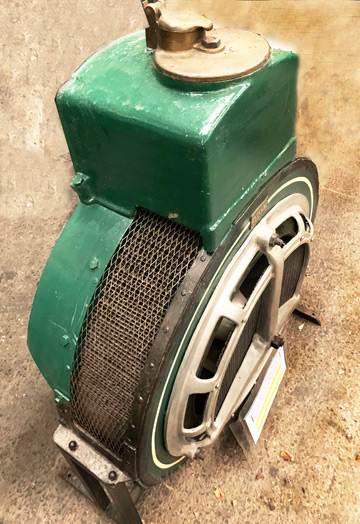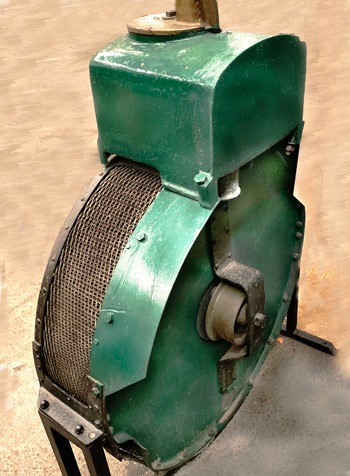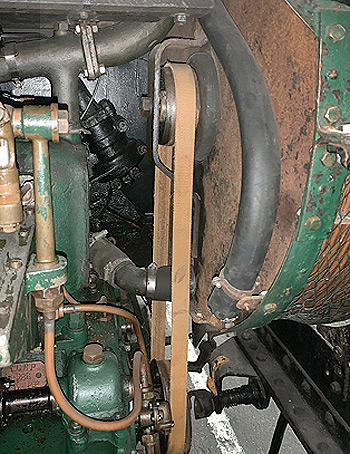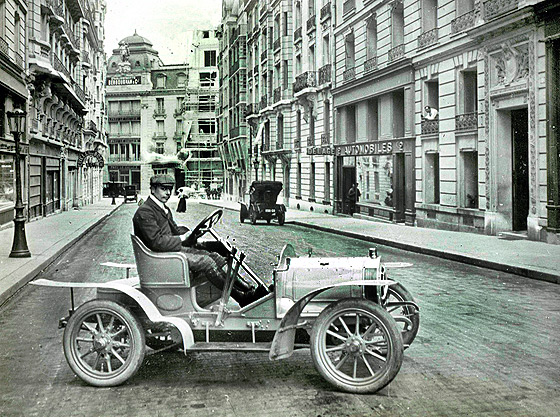|
Our fount of incredible
general knowledge, Ariejan Bos, agrees with likelihood that the driver
being depicted on this photograph is Giosue Giuppone. Amazingly Ariejan
also advises that the business residents of Rue Villaret-de-Joyeuse in
Paris were: Civelli de Bosch, also the Grégoire agent, was at nunber 3;
Maison Creteuil was agent for Delage at number 2 from the end of 1906
onwards; Bergougnan, the Paris depot for Le Gaulois tyres was at number 9.
This means that the Lion Peugeot is standing more or less in front of
number 1 (on the left), where an agent for Peugeot cycles had its
premises. Peugeot cycles were part of Peugeot Frères, also responsible
for Lion Peugeot. Goudard and Mennesson (Solex) were located nearby in
Nueilly-sur-Seine. No street parking problems ! |
Giosue Giuppone
(1878-1910)
We are advised that the driver in the photo is Giosue Giuppone , initially
an Italian cycling champion at the turn of 1900s with over 250 races, many
of which bought him success and fame. Although renowned for long distance
and cross-country cycling events, most of his successes came in middle
distance events in Italian Cycling Championships of 1903 and 1904.
He also became very well known in Italian cycle racing Velodromes where
motorcycles (Entaineurs) would be pacing the cylists (Stayers) reaching
speeds of 100+kph riding in the motorcycle slipstream.
At that time Giosue was working as a
mechanic for a Turin company who were the representatives in Italy for
Peugeot bicycles and motorcycles. As both were at the centre of Italian
Velodrome racing, Giosue began to compete as both a Enteineur and a Stayer,
and also as a Coach, featuring Peugeot bicycles and motorcycles.
Further successes resulted on him being signed on by Peugeot and
eventually moving to France where he became the darling of the French cycle road races and the Velodrome scene,
|
This part of Peugeot bicycles
and motorcycles was under the auspices of Lion Peugeot, the continuation
of the old part of Peugeot, 'Fils de Peugeot Freres'. Despite the
agreement that the breakaway part "Société des Automobiles
Peugeot" were the only ones to make cars, 'FIls' did go into
production of automobiles as "Lion Peugeot' and paid a royalty on
every car to their cousins.
Giosue Giuppone was employed by Robert
Peugeot to be their first 'works driver' for Lion Peugeot, racing their
small car in the under 450kg class. The guys to beat at the time in this
class were Sizaire and Naudin, against whom Peugeot fielded models based
on their VA and the VC models. These soon began to gain supremacy, and in
the 1908 and 1909 seasons and Lion Peugeot became the 'Team to Beat'.
Giosue Giuppone was unfortunately killed
practicing for the 1910 Coupe des Voiturettes trying to avoid a cyclist
crossing the road, resulting in rolling the car, which killed Giosue and
injuring the riding mechanic. The photo above was taken apparently in 1906
which would have been the beginning of his Lion Peugeot Automobile career.
The two arms of Peugeot re-joined in 1910, amalgamating car production.
|
Goudard & Mennesson develop the SOLEX Centrifugal Radiator.
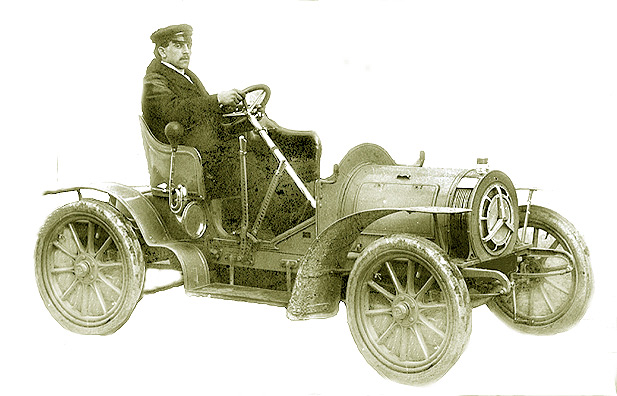
The radiator at the front of this car,
similar or same as the enquiry, was a
"bolt-on-goody" made by the Goudard & Mennesson company in
Neuilly-sur-Seine, Paris, formed 1906, from an idea of Goudard and money
from Mannesson's Gramdmother. It was not an immediate success in the
private car market, and it was not until the Paris General Omnibus Company
launched a competition for the supply of 400 radiators for their busses,
which G&M won in 1909, that manufacture began to increase. The
trademark "Solex" was officially introduced in 1910 and all GOC
Paris vehicles from then until 1926, whatever make, had to use the Solex
radiator. Most old postcards of Paris show busses with the three-pointed
star on the radiator indicating a Solex radiator, (which had absolutely
nothing to do with Mercedes). The success with the CGO extended the Solex
radiator into use on French commercial vehicles and lorries and many
manufacturers used them on their very heavy vehicles. A notable example
was the De Dion Bouton company, which was exporting Solex radiatored
lorries all over the world, including the USA.
The design of the "Solex" circular centrifugal
radiator and early patents for it, started when cars did not have a front
mounted radiator but had 'coalscuttle alligator bonnets', with the
radiator being located behind the engine by the bulkhead, a-la Renault.
Basic engine cooling started with simple air passing over the engine, but
as the number of cylinders and their size grew, so cool air was not
reaching the back cylinders and water cooling had to be introduced.
Development of a simple thermosyphon tank holding recycled hot water soon
resulted in external finned tube radiators, which later had ventilator
fans propelling air through the matrix. Goudard & Mannenson had
determined early-on that the employment of the ordinary helical/screw type
of fan behind a conventional flat honeycomb radiator was not very
efficient because much of the air is churned up behind the radiator and
never gets near to the cooling surfaces of the tubes, and results in lots
of waste of power and no cooling.
The Solex radiator is an entirely self-contained narrow
circular section unit, which can have the air inlet at either the front or
at the back of the unit. Envisage a car tyre where the tyre tread would be
the exit cooling matrix. One of the open centres of the tyre, where the
wheel would be, would be the inlet, and the other open centre would be
completely closed off. Whichever side is the entry, the other side is
closed off. In the middle of the central area is a big wide flat bladed
fan (envisage Mississippi steamer with large side paddles) which exhausts
the air tangentially from the centre out through the cooling tube matrix
in the periphery of the circular housing.
In the case of the of the rear mounted Radiator the air
would be drawn up at the rear below the floorboards of the car, would
enter the radiator going forward and exit via the cooling tubes on the
periphery. No air is able to go through into the engine compartment
because the side is blanked off, so no dirt can enter the engine bay. When
Solex eventually introduced the front mounted radiator, this was reversed
and the 'open side' of the radiator assembly was always supplied as
standard with a decorative front grille with a three-point fan mounting bracket
which gave the impression of a Mercedes logo (no connection with
Mercedes). Front air entry was through the wire gauze on the
face and through the raised front openings, and rear entry in this case was closed off.
The 'cooling core' of the rear or front mounted
radiator, (the 'tyre tread' in the analogy). is comprised of two
semi-circular batteries of closely bundled copper tubes, one running
top-to-bottom along the left outer edge of the housing and the other along
the right outer edge. Each side has its own water header and there is also
a main supply header/reservoir fitted to the top of the housing. The
Radiator would be supplied as a complete separate cased unit ready to bolt
directly to the chassis and would operate on a thermosyphon system with
hoses to the engine water jacket. The only external thing needed would be
a shaft drive to a pulley, and a belt, to drive the centrifugal fan.
Ideally, the car would need to have a circular bonnet to accommodate the
round Radiator. And this was one of the drawbacks.
We have covered previously the subject of the development of the De
Dion Bouton Company, which used Solex
radiators exclusively on their Commercial Vehicles, at some depth
relative to an enquiry from the American Chamber of Commerce in Manila
in the Philippine on the subject of De Dion Bouton involvement in the
origination of Bagio
Town and the Kennon Snake Road.
Sales of Solex radiators
began eventually to decline so Goudard & Mennesson purchased a small
carburetor maker Jouffret and Renée and re-named the products Solex. The
Solex carburetor became world famus and had factories in a number of
countries. After World War II Goudard & Mennesson went into
manufacture of front engined bicycles which they had developed earlier,
and made the first of the eight million VeloSolex motorised
bicycles, which became trademark of France. History of these vehicles we
covered in an article http://www.svvs.org/junebug20.shtml
, half way down.
It may also be worth noting that our
Member Michel Gossett has a direct connection with the Solex operations of
the time. One of Michel's two Jaguars, both with steering wheels on the
wrong side, is a 1955 Jaguar Mark Seven which belonged to the then Solex
Managing Director Maurice Goudard as his personal transport but which was
also a mobile test-bed for experiments with Solex carburetors. This is
presumably why Michel also had a VeloSolex.
|
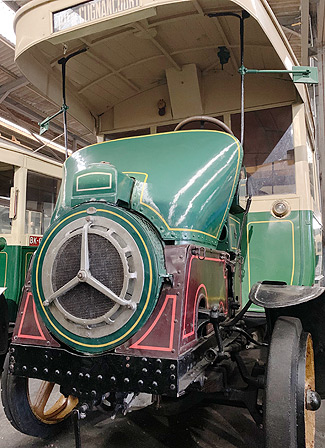 |
 |
|
Photos courtesy Jean-Max
Rouchon ; URBAN TRANSPORT MUSEUM. PARIS, FRANCE Click
to enlarge below |
| Solex Radiator Front |
Solex Radiator Back |
Solex Radiator Core and Fan |
Solex Radiator Fitted to Drive |
Go to Recent Venues
Page
PICTURE GALLERY INDEX
|


